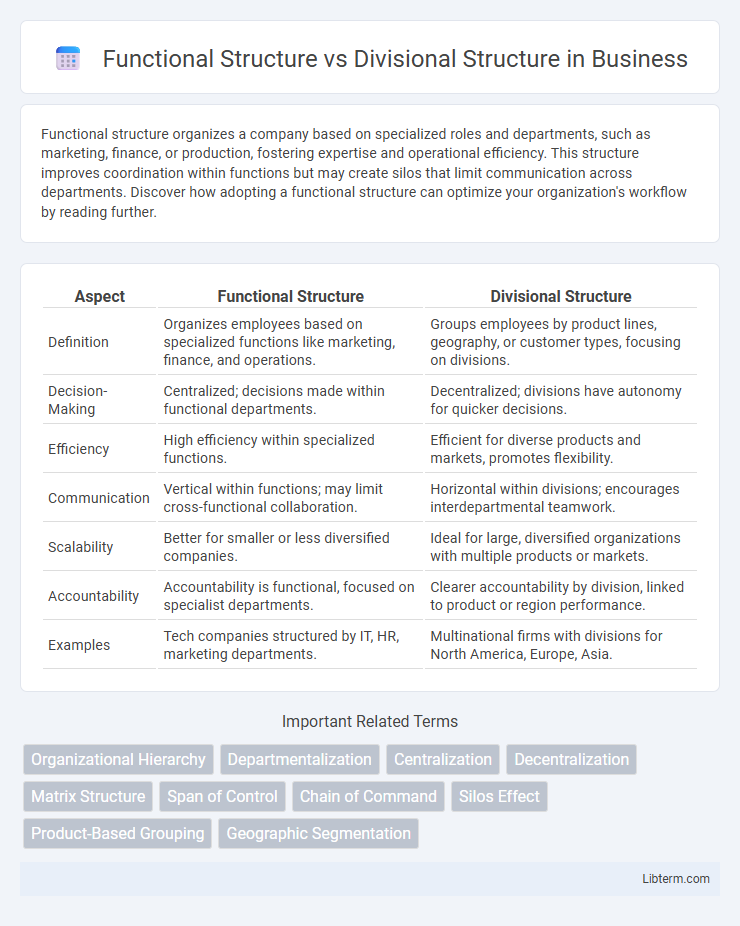Functional structure organizes a company based on specialized roles and departments, such as marketing, finance, or production, fostering expertise and operational efficiency. This structure improves coordination within functions but may create silos that limit communication across departments. Discover how adopting a functional structure can optimize your organization's workflow by reading further.
Table of Comparison
| Aspect | Functional Structure | Divisional Structure |
|---|---|---|
| Definition | Organizes employees based on specialized functions like marketing, finance, and operations. | Groups employees by product lines, geography, or customer types, focusing on divisions. |
| Decision-Making | Centralized; decisions made within functional departments. | Decentralized; divisions have autonomy for quicker decisions. |
| Efficiency | High efficiency within specialized functions. | Efficient for diverse products and markets, promotes flexibility. |
| Communication | Vertical within functions; may limit cross-functional collaboration. | Horizontal within divisions; encourages interdepartmental teamwork. |
| Scalability | Better for smaller or less diversified companies. | Ideal for large, diversified organizations with multiple products or markets. |
| Accountability | Accountability is functional, focused on specialist departments. | Clearer accountability by division, linked to product or region performance. |
| Examples | Tech companies structured by IT, HR, marketing departments. | Multinational firms with divisions for North America, Europe, Asia. |
Introduction to Organizational Structures
Functional structure organizes a company based on specialized roles and departments such as marketing, finance, and operations, enhancing operational efficiency and expertise. Divisional structure segments the organization into semi-autonomous units based on products, services, or geographic regions, promoting flexibility and better market responsiveness. Choosing between these structures depends on the company's size, strategy, and complexity, impacting coordination and communication patterns.
Overview of Functional Structure
A functional structure organizes a company based on specialized departments such as marketing, finance, and operations, enhancing efficiency through focused expertise. This structure promotes clear roles and responsibilities, supporting streamlined communication within functions but may limit interdepartmental collaboration. It is ideal for organizations emphasizing operational efficiency and standardized processes in stable environments.
Key Features of Functional Structure
Functional structure organizes a company based on specialized functional areas such as marketing, finance, and operations, enabling efficiency through task specialization and expertise development. It promotes clear hierarchical lines, centralized decision-making, and streamlined communication within each function. This structure is best suited for organizations with a stable environment and standardized products or services, as it enhances operational efficiency but may hinder flexibility and interdepartmental coordination.
Overview of Divisional Structure
The divisional structure organizes a company into semi-autonomous units based on product lines, geographic regions, or customer segments, enabling focused strategies and faster decision-making within each division. Each division operates with its own resources, including marketing, sales, and production, enhancing flexibility and accountability compared to the more centralized functional structure. This approach suits large, diversified organizations by fostering innovation and responsiveness to market changes while maintaining overall corporate coordination.
Key Features of Divisional Structure
Divisional structure organizes a company into semi-autonomous units based on products, markets, or geography, each with its own functional teams such as marketing, sales, and finance. Key features include decentralized decision-making, allowing divisions to respond quickly to market changes and customer needs. This structure enhances accountability and operational focus by clearly defining responsibility within each division, promoting flexibility and faster performance evaluation.
Functional Structure: Advantages and Disadvantages
A functional structure organizes a company based on specialized roles such as marketing, finance, and production, enhancing operational efficiency and expertise within departments. This structure promotes clear career paths and streamlined communication within functions but can lead to silos, reduced interdepartmental collaboration, and slower response to market changes. Companies with stable environments benefit from functional structures, while those needing flexibility may face challenges due to its rigid hierarchy and potential for limited innovation.
Divisional Structure: Pros and Cons
Divisional structure organizes a company into semi-autonomous units based on products, markets, or geography, enhancing accountability and specialization within each division. It allows for quicker decision-making and better responsiveness to market changes, but can lead to duplicated resources and potential conflicts between divisions. The structure supports strategic focus and customer orientation but may increase operational costs and create challenges in maintaining consistent company-wide policies.
Comparing Functional and Divisional Structures
Functional structure organizes a company based on specialized roles and departments, such as marketing, finance, and production, promoting operational efficiency and deep expertise. Divisional structure groups activities by product lines, geographical regions, or markets, enhancing flexibility and responsiveness to specific customer needs. While functional structures streamline internal processes, divisional structures offer better accountability and adaptability in diverse business environments.
Factors to Consider When Choosing a Structure
Choosing between a functional structure and a divisional structure depends on factors such as company size, product diversity, and geographic dispersion. Functional structures suit organizations with a narrow product range and centralized operations, emphasizing specialization and efficiency. Divisional structures benefit large, diversified firms by enabling greater flexibility, accountability, and responsiveness to market needs.
Conclusion: Selecting the Right Structure for Your Organization
Choosing between a functional structure and a divisional structure depends on the organization's size, complexity, and strategic goals. Functional structures enhance operational efficiency by grouping specialized tasks, ideal for smaller or centralized firms, while divisional structures support flexibility and product or market focus, suitable for larger, diversified organizations. Aligning the organizational structure with business objectives ensures improved communication, decision-making, and overall performance.
Functional Structure Infographic

 libterm.com
libterm.com